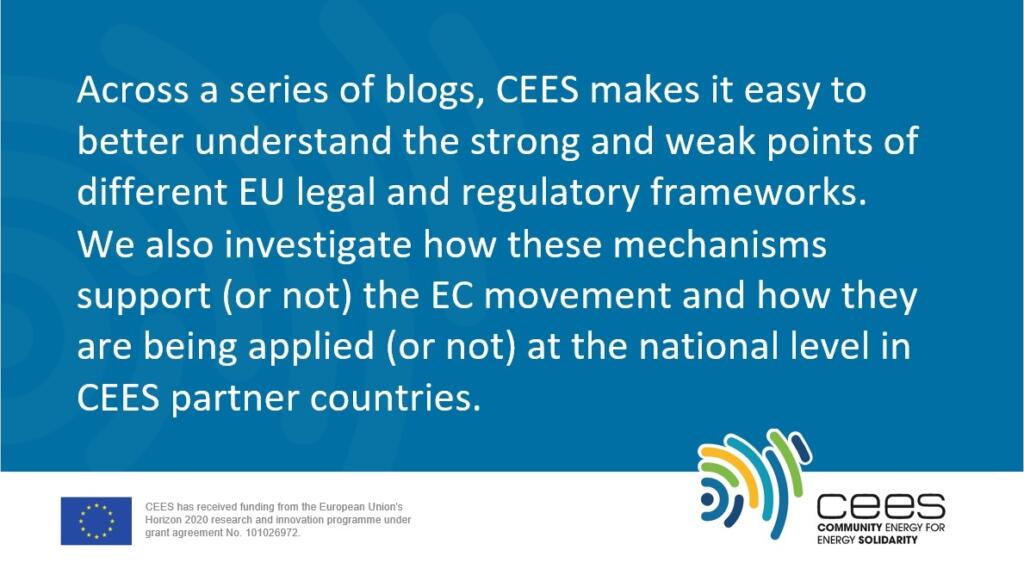The Clean Energy Package (CEP) officially recognises and reinforces the central role that citizens and communities can and must play in the energy transition by actively participating in the energy market.[i] Importantly, energy poverty considerations are embedded in many of its legislative acts.
Conceived as part of the update to the EU energy legal and policy framework in 2018-19, the CEP aimed to deliver on the Union’s commitments to the Paris Agreement to reduce greenhouse gas emissions. Building on the 2030 targets set out by the Commission in 2014 in the energy and climate framework, and the 2015 Energy Union Strategy, the update established concrete ways to implement the objectives and dimensions set out in both.[ii]
The CEP is composed of four directives[iii] and four regulations.[iv] CEES investigated the most important provisions concerning energy poverty and energy communities. First to go under the microscope in a series of blog posts: the Internal Market for Electricity Directive (IEMD).
Empowering and protecting consumers
The IEMD aims to both empower and protect consumers within energy markets across Europe. The Directive explicitly recognises the essential role that consumers will play to achieve specific targets, such as the increase of renewable energy generation and flexibility, and aims to provide a set of rights and tools to ensure their effective participation.[v]
In line with its predecessor, Directive 2009/72/EC, the IEMD obliges Member States to ensure adequate consumer protection and defines the concept of “vulnerable consumers.”[vi] Member States also need to ensure consumer’s right to good quality energy at reasonable, transparent, comparable, and non-discriminatory prices. Their actions, however, must not interfere with the operation of the market, as a smoothly working market is considered essential for a fair transition. The same article introduces a legal requirement for Member States to take appropriate measures to address energy poverty “where identified”[vii] and connects this to new provisions in the Governance Regulation, requiring Member States to assess the number of households in energy poverty.[viii] Article 29 of the IEMD requires that the concept of “energy poverty” be established at the national level, using “a set of criteria, which may include low income, high expenditure of disposable income on energy, and poor energy efficiency.”[ix]
Empowerment through community energy
In turn, community energy is acknowledged in the IEMD as an “effective and cost-efficient way to meet citizen’s needs and to boost consumer engagement and participation within the energy system.”[x] The Recitals to the IEMD recognise its capacity to empower and protect consumers. Specifically, Recital 43 states that:
“Community energy can also advance energy efficiency at household level and help fight energy poverty through reduced consumption and lower supply tariffs. Community energy also enables certain groups of household customers to participate in the electricity markets, who otherwise might not have been able to do so.”[xi]
Article 16 of the IEMD defines the concept of citizen energy communities (CECs) and obliges Member States to provide an enabling framework for CECs. It does not, however, explicitly reinforce their role in tackling energy poverty, enabling access to renewable energy for vulnerable consumers or boosting their engagement within the energy system. As such, the IEMD lacks any concrete provisions elaborating how Member States should address or support tackling energy poverty through energy communities.
[i] REScoop.eu & ClientEarth (2020). Energy Communities under the Clean Energy Package.
[ii] Kehoe & Hancher (2020, November). Governance of the Energy Union.
[iii] Energy Performance of Buildings Directive, Renewable Energy Directive, Energy Efficiency Directive, and the Common rules for the internal market for electricity Directive
[iv] Governance of the Energy Union and Climate Action Regulation, Risk-preparedness in the electricity sector Regulation, European Union Agency for the Cooperation of Energy Regulators Regulation, and the Internal Market for Electricity Regulation
[v] Directive (EU) 2019/944, Recital 10 and Chapter III Consumer Empowerment and Protection.
[vi] Directive (EU) 2019/944, Article 28.
[vii] Directive (EU) 2019/944, Article 28.
[viii] Regulation (EU) 2018/1999, Recital 26 and Article 3.
[ix] Directive (EU) 2019/944, Article 29.
[x] Directive (EU) 2019/944, Recital 43.
[xi] Directive (EU) 2019/944, Recital 43.

